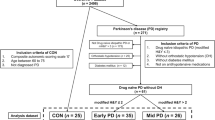Abstract
The valsalva manoeuvre (VM), used as an autonomic function test, can detect sympathetic and/or parasympathetic autonomic dysfunction. This study investigated the value of VM in patients with different Parkinsonian syndromes (PS). We continuously recorded blood pressure, ECG and respiration among 38 patients with multiple system atrophy (MSA), 32 patients with progressive supranuclear palsy (PSP), 26 patients with idiopathic Parkinson’s disease (PD) and in 27 healthy subjects matched in age and sex (Con). VM was performed in addition to metronomic breathing and tilt-table testing. VM could not be analysed in 26% of the ES patients. Valsalva ratio (VR), as a parameter of cardiovagal function, was pathologically decreased in all patient groups. Valsalva ratio (VR) was not able to discriminate parasympathetic dysfunction between patients and controls as well as E/I ratio of metronomic breathing. As a parameter of sympathetic dysfunction during VM, the physiological increase of blood pressure was more often missing during phase IV than phase II especially in PD and MSA patients. Correlation with orthostatic hypotension during tilt-table testing was only moderate. Although VM can demonstrate sympathetic and parasympathetic autonomic dysfunction, we cannot recommend VM as a first line autonomic test in PS patients. Metronomic breathing and tilt-table test seem more capable as parasympathetic resp. and sympathetic function tests to identify cardiovascular abnormalities in PS patients.


Similar content being viewed by others
References
Bouhaddi M, Vuillier F, Fortrat JO, Cappelle S, Henriet MT, Rumbach L, Regnard J (2004) Impaired cardiovascular autonomic control in newly and long-term-treated patients with Parkinson’s disease: involvement of l-dopa therapy. Auton Neurosci 116:30–38
Freeman R (2006) Assessment of cardiovascular autonomic function. Clin Neurophysiol 117:716–730
Friedrich C, Rüdiger H, Schmidt C, Herting B, Prieur S, Junghanns S, Schweitzer K, Globas C, Schöls L, Berg D, Reichmann H, Ziemssen T (2008) Baroreflex sensitivity and power spectral analysis in different extrapyramidal syndromes. J Neural Transmission 115:1527–1536
Gilman S, Low P, Quinn N, Albanese A, Ben-Shlomo Y, Fowler C, Kaufmann H, Klockgether T, Lang A, Lantos P, Litvan I, Mathias C, Oliver E, Robertson D, Schatz I, Wenning G (1998) Consensus statement on the diagnosis of multiple system atrophy. American Autonomic Society and American Academy of Neurology. Clin Auton Res 8:359–362
Goldstein DS (2003) Dysautonomia in Parkinson’s disease: neurocardiological abnormalities. Lancet Neurol 2:669–676
Goldstein DS, Pechnik S, Holmes C, Eldadah B, Sharabi Y (2003) Association between supine hypertension and orthostatic hypotension in autonomic failure. Hypertension 42:136–142
Goldstein DS, Eldadah BA, Holmes C, Pechnik S, Moak J, Saleem A, Sharabi Y (2005) Neurocirculatory abnormalities in Parkinson disease with orthostatic hypotension: independence from levodopa treatment. Hypertension 46:1333–1339
Gutrecht JA (1992) Autonomic cardiovascular reflexes in progressive supranuclear palsy. J Auton Nerv Syst 39:29–35
Hilz MJ, Dutsch M (2006) Quantitative studies of autonomic function. Muscle Nerve 33:6–20
Holmberg B, Kallio M, Johnels B, Elam M (2001) Cardiovascular reflex testing contributes to clinical evaluation and differential diagnosis of Parkinsonian syndromes. Mov Disord 16:217–225
Kimber J, Mathias CJ, Lees AJ, Bleasdale-Barr K, Chang HS, Churchyard A, Watson L (2000) Physiological, pharmacological and neurohormonal assessment of autonomic function in progressive supranuclear palsy. Brain 123(Pt 7):1422–1430
Litvan I, Agid Y, Calne D, Campbell G, Dubois B, Duvoisin RC, Goetz CG, Golbe LI, Grafman J, Growdon JH, Hallett M, Jankovic J, Quinn NP, Tolosa E, Zee DS (1996) Clinical research criteria for the diagnosis of progressive supranuclear palsy (Steele-Richardson-Olszewski syndrome): report of the NINDS-SPSP international workshop. Neurology 47:1–9
Looga R (2005) The Valsalva manoeuvre—cardiovascular effects and performance technique: a critical review. Respir Physiol Neurobiol 147:39–49
Low PA (1993) Laboratory evaluation of autonomic failure. In: Low PA (ed) Clinical autonomic disorders. Little, Brown and Company, Boston, pp 169–196
Mesec A, Sega S, Kiauta T (1993) The influence of the type, duration, severity and levodopa treatment of Parkinson’s disease on cardiovascular autonomic responses. Clin Auton Res 3:339–344
Oka H, Morita M, Onouchi K, Yoshioka M, Mochio S, Inoue K (2007a) Cardiovascular autonomic dysfunction in dementia with Lewy bodies and Parkinson’s disease. J Neurol Sci 254:72–77
Oka H, Yoshioka M, Onouchi K, Morita M, Mochio S, Suzuki M, Hirai T, Urashima M, Inoue K (2007b) Impaired cardiovascular autonomic function in Parkinson’s disease with visual hallucinations. Mov Disord 22:1510–1514
Riley DE, Chelimsky TC (2003) Autonomic nervous system testing may not distinguish multiple system atrophy from Parkinson’s disease. J Neurol Neurosurg Psychiatry 74:56–60
Schmidt C, Herting B, Prieur S, Junghanns S, Schweitzer K, Globas C, Schols L, Antoni S, Ferger D, Reichmann H, Wilhelm H, Berg D, Ziemssen T (2007) Pupil diameter in darkness differentiates progressive supranuclear palsy (PSP) from other extrapyramidal syndromes. Mov Disord 22:2123–2126
Schmidt C, Herting B, Prieur S, Junghanns S, Schweitzer K, Globas C, Schöls L, Reichmann H, Berg D, Ziemssen T (2008) Autonomic dysfunction in different subtypes of multiple system atrophy. Mov Disord 23:1766–1772
Wieling W, Karemaker JM (1999) Measurement of heart rate and blood pressure to evaluate disturbances in neurocardiovascular control. In: Mathias CJ, Bannister SR (eds) Autonomic failure. Oxford University Press, Oxford, pp 196–210
Ziemssen T, Reichmann H (2007) Non-motor dysfunction in Parkinson’s disease. Parkinsonism Relat Disord 13:323–332
Author information
Authors and Affiliations
Corresponding author
Rights and permissions
About this article
Cite this article
Schmidt, C., Herting, B., Prieur, S. et al. Valsalva manoeuvre in patients with different Parkinsonian disorders. J Neural Transm 116, 875–880 (2009). https://doi.org/10.1007/s00702-009-0239-4
Received:
Accepted:
Published:
Issue Date:
DOI: https://doi.org/10.1007/s00702-009-0239-4




